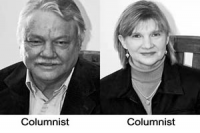The Donald Trump Law of Negotiating
Gordon Mercer and Marcia Mercer Global Digital Post: “I like thinking big. I aim very high, and then I just keep pushing and pushing and pushing to get what I’m after. The best thing you can do is deal from strength, and leverage is the biggest strength you can have. Leverage is having something the other guy wants.” Donald Trump, "Trump: The Art of The Deal"

Franklin, NC -- (ReleaseWire) -- 11/02/2010 -- It was Marcia’s first visit to New York City. She is not a fan of cities and New York was high on her “most likely never to go there” list. So, it was surreal when Saturday night found Gordon and Marcia walking through Central Park towards Times Square and after more walking staring up at Trump Tower with the famous board room, where Donald Trump fires apprentices. We were in New Jersey for a meeting of Pi Gamma Mu International Honor Society and had taken the ‘A’ train from Fort Lee to New York City. Gordon had been to New York, likes cities and Marcia gradually found herself warming as the ‘A’ train passengers and locals were especially friendly and helpful.
Trump Tower is beside Tiffany and was the tallest building of its type in New York City, when completed in 1983. It is lovely with public spaces of marble and large brass mirrors. Gordon was currently brushing up on the negotiating sections from Donald Trump’s book, “Trump: the Art of the Deal,” for his classes. He teaches Public Policy and American Government, which have sections on negotiating.
Reading “Trump: The Art of the Deal” is like moving from one adventure to the next. While Trump does not identify one basic law, the above composite of quotes seems to describe his approach to negotiating. We learned, for example, that Trump Towers took incredible persistence with air-space, land rights, zoning and financing all requiring negotiations. Often we think of negotiations as one primary deal but completion of the Tower required multiple deals and much pushing. Trump is astute and never enters negotiations before discerning what the other person most wants. Trump also has a unique understanding of what he wants and aims high.
Night approached and we scouted for restaurants. Rejecting several as touristy (we wanted to go where the locals go); we chose a small Thai restaurant whose lighting was mostly candlelight. It was charming, (energy efficient) and had excellent food.
Journeying home, we began thinking about uniquely effective projects in Franklin, N. C. that had required negotiations. The environments are different but the skills remain the same.
We thought about the Little Tennessee River Greenway, one of the more important sites in North Carolina. The Greenway attracts tourists with its diversity of wildlife and history. In 1997 when power lines were to be built by Duke Power who owned Nantahala Power and Light, a steering committee of Ed Tucker, president of Nantahala Power and Light, Mayor Ed Hinson, Mayor Joe Collins, Tom Smitherman, Vice President of NP&L, County Manager Sam Greenwood, Peg Jones and Brian Hyder was appointed by Duke and Nantahala Power and Light. Barbara McRae, then with NP&L, agreed to write grants for initial funding. Duke Power and Nantahala Power provided the engineering. Bill McLarney with the Little Tennessee Watershed Association had completed research and held conferences on the river’s health and aquatic life. He inspired others to want to preserve areas of the Little Tennessee River.
The new steering committee wanted to preserve our heritage of natural beauty with a trail and habitat preservation in a way that would bring economic development and adequate power lines to Franklin. The vision paid off and The Greenway was born. Key groups supporting the project included the Nantahala Hiking Club, Macon County, Town of Franklin, Duke Power, Friends of the Greenway ( FROGs), Southwestern Community College, Nantahala Power and light, North Carolina Clean Water Trust Fund, North Carolina Parks and Recreational Trust Fund, Land Trust for the Little Tennessee and F. P. “Bodie”Bodenheimer of Zickgraf Industries, the Little Tennessee Watershed Association, Franklin Press and WFSC Radio. This list of supporting groups has grown tremendously. The Little Tennessee River Greenway webpage gives a complete history of the project.
Negotiations and futuristic planning are vital in communities. Big thinking, persistence and the ability to organize and respect mutual needs and interests are valuable negotiating skills and important to the success of communities. Negotiations at their best result in a win-win for all interested parties. This was the case with the project in Franklin. The creation of the Little Tennessee Greenway has ensured future generations will enjoy the tranquil timeless paths and trails the Cherokee and the Mound Builders once traveled.
We recommend reading, “Trump: The Art of the Deal.” It is an exciting classic that has survived the test of time.
Gordon Mercer is international president of the Pi Gamma Mu International Honor Society and a professor of political science at Western Carolina University (WCU). He holds a Ph.D. degree in organizational development, founded the Public Policy Institute at WCU in 1999, and has held the position of associate dean of research and graduate Studies at the university. Marcia Mercer is a writer and published columnist with the Franklin Press. Go to http://9955.hostednr.com to get to our Notes on Quotes Press Room. Views expressed in this column are the views of the authors and do not reflect the views of other organizations.
Media Relations Contact
Marcia Mercer
Columnist
Notes on Quotes
828-369-2693
http://9955.hostednr.com
View this press release online at: http://rwire.com/62700